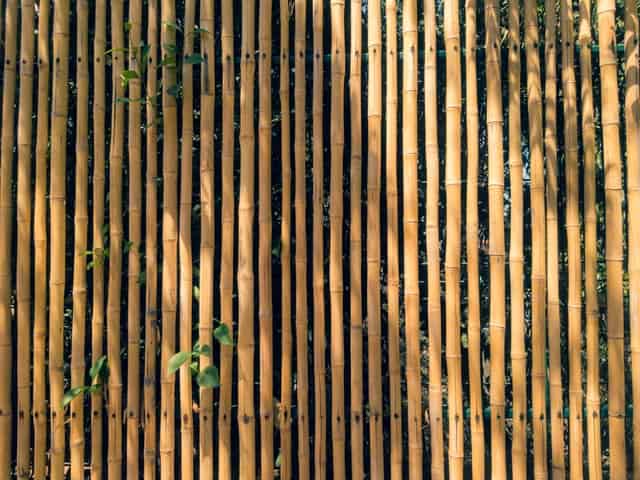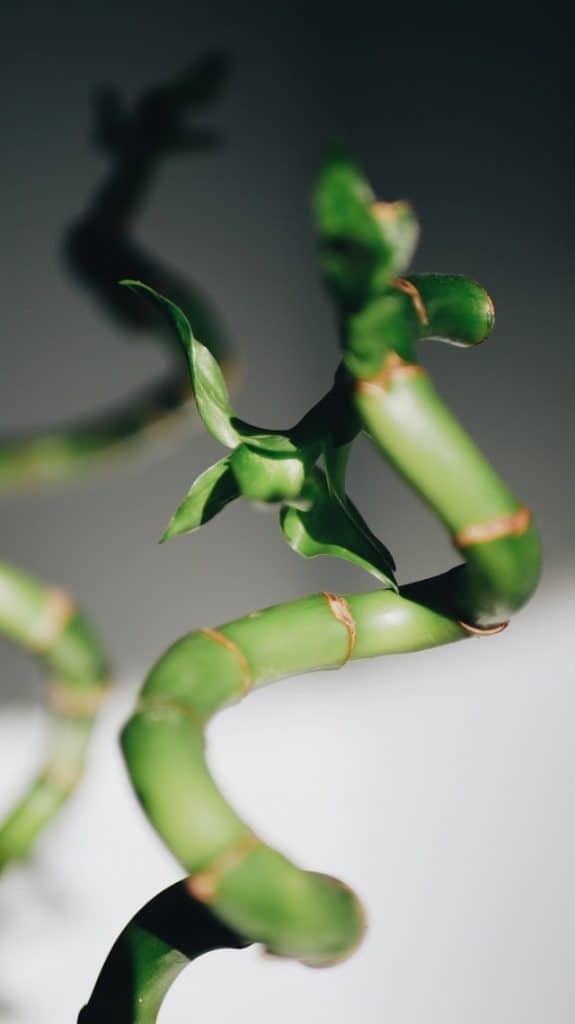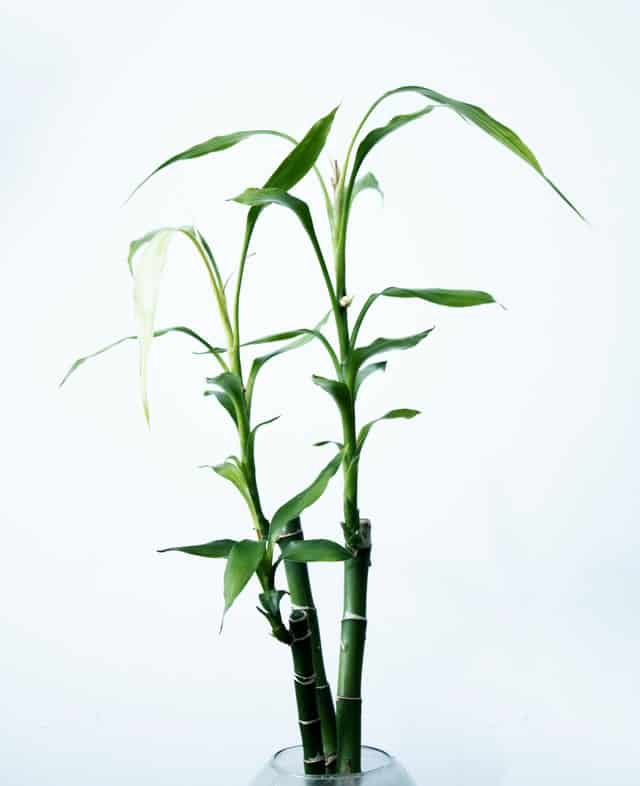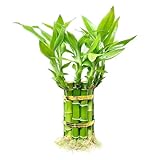Having an indoor bamboo plant has become incredibly popular over the last few years. They are actually exceptionally stylish as vegetation for a home office setup or around the house!
As a type of evergreen plant, they provide eye-catching, abundant vegetation that can instantly give an exotic and lively feel to any space.
Not to mention it is also widely considered to have an auspicious meaning. It is an evergreen grass that is lovely as an indoor plant and readily accessible throughout the year.
We’ll show you how to look after your plant, delve into the meaning, its origin and more!
Jump to:
Origin
The plant is native to China. The earliest record of the plant’s uses comes from this country. In ancient China, the plant was used to make books, food like braised bamboo shoots, housing and even weapons.

Nowadays, this evergreen grass can be found in most parts of the continent. This is thanks to the variety of bamboo plants available.
Health Benefits
Bamboo eliminates benzene, trichloroethylene and also formaldehyde. Likewise, it adds moisture to the atmosphere and works as a natural humidifier for the space it is in.
Types
There are many different types of bamboo plants but they are generally split into two categories. These are running and clumping.
Clumping
Clumping bamboo grows in a large amount of grass and stays where it has been planted. It does not spread by itself and is a good choice for people who want a well-planned garden.
These come in the straight and curly form are usually the type used for indoor bamboo plants.
Running
Running bamboo is the other category. As the name suggests, this type of bamboo plant is invasive and will spread easily if not carefully looked over. It grows through extending rhizomes in the soil.
These underground runners can move more than 30 meters before sprouting.
We don’t recommend planting this unless you have a containing system to maintain its position. This could be done using metal sheeting or a root barrier.
Otherwise, you’ll get into a lot of trouble when the neighbours complain about their new bamboo plants that just popped up!
Common Bamboo Varieties
Within the two categories, bamboo plants are also divided into warm and cold climates the variety can survive in.
There are commonly two types of cold climate clumping bamboo plants. These are Chinese Mountain and Umbrella bamboo.
The warmer your climate, the more options you have for different types of bamboo. Some warm-climate types of clumping bamboo varieties include Chinese Goddess, Hedge bamboo, Fernleaf and Silverstripe.
Best Indoor Bamboo Plant Types
Here are some of the best indoor bamboo plants to suit your space!
- Lucky Bamboo
- Kentia Palm
- Areca Palm
- Chamaedorea Elegans
- Rhapis excelsa
- BRING GOOD FORTUNE HOME: This Lucky Bamboo live plant is a classic symbol of luck and prosperity in Asian cultures. A unique, stylish real plant that shines as a decorative accent for an office desk, home entryway, or kitchen counter
- EASY TO MAINTAIN, BEGINNER-FRIENDLY INDOOR PLANT: The Lucky Bamboo is a resilient, low-maintenance houseplant that thrives on neglect, making it perfect for any level of plant owner. It’s an ideal, hassle-free choice for busy individuals or new plant
- CREATE A CALMING SANCTUARY: A classic symbol of good fortune, this bamboo plant creates a calming, balanced environment that enhances positive mood and wellbeing
- PERFECT GIFT FOR ANY OCCASION: This living and thoughtful present is ideal for birthdays, housewarmings, holidays, or just because. Brighten a loved one's day with a beautiful indoor plant
- FRESH PLANT, READY FOR YOUR HOME: Your beautiful, healthy live indoor plant, fresh from our farm, arrives secured in specialized packaging right to your home
- Perfect Desk Mate: A set of ten 4-inch stalks is the ideal size for any desk, shelf, or small space. Their compact nature brings a serene, green touch without taking up precious room.
- Gift-Ready Presentation: This charming size is our most popular gift option! Ready to be gifted for birthdays, graduations, or as a thoughtful token of appreciation. Sparks joy instantly.
- Low Maintenance Ease: Thrives in a small vase or cup with just water. An effortless way to start your plant journey or add more life to your workspace.
- Feng Shui Flexibility: Arrange these ten small stalks in a circle for unity or in a creative pattern to channel specific Feng Shui intentions for wealth and relationships.
- Great for Offices: Low-light tolerant and hassle-free, it's the perfect live plant to brighten up cubicles, reception areas, and home offices.
- Premium live lucky bamboo plants indoor set of three stalks with height variation - two 4-inch and one 6-inch for dynamic desk decor in homes or offices.
- Easy-care low maintenance plants thriving with weekly water changes using distilled water, ideal for beginners in indirect light conditions.
- Authentic Feng Shui good luck stalks attracting positive energy and prosperity as traditional office desk decor or home wealth symbols.
- Versatile no pot needed decor solution - display stalks in glass vases or ceramic planters for shelf, bathroom, or tabletop settings.
- Meaningful gift ready lucky bamboo for new homes, symbolizing growth and prosperity as housewarming gifts for colleagues or graduates.
Indoor Bamboo Plant Care
Bamboo generally requires minimal upkeeping and is a sturdy plant. It rarely has challenges with pests or disorders, and it usually doesn’t need pruning.
You could get rid of old canes at their foundation if they begin to look unhealthy.
In addition, you also can get rid of new shoots as they pop up from the soil if you'd like to restrict your indoor bamboo plant’s expansion.
Typical watering and feeding can make up the bulk of the plant's routine maintenance. To take care of the soil moisture that bamboo likes, you might have to water your plant more than once per week.
But specifically for an indoor plant where the local weather doesn’t adjust dramatically, try to be in a position to establish a predictable treatment for your plant.
Sunlight
Bamboo prefers a spot that will get a whole lot of sunshine compared to partial shade. An excessive amount of shade may end up in a weak plant that does not mature to its fullest.
This will result in the plant having fainter colours and less vibrant. Keep your indoor bamboo plant by the brightest window in the room.
Regularly rotate the pot every 7 days or so to be sure all sides of the plant gets an equal amount of sunlight.
Soil
Indoor bamboo plants can tolerate a variety of soil types. However, it prefers organically rich soil with great drainage capabilities.

Watering
Bamboo can tolerate drought and can also handle very wet soil for a short time. However, if it is left sitting in a pool of soggy soil or drinking water, this can rot the roots. In this case, this is beyond salvaging and you will need to get rid of the plant. The plant prefers evenly moist soil.
Check the soil by sticking your finger an inch or two in it and watering it every time it feels dry. Never let the soil dry out completely. However, during the winter season, reduce to watering of your indoor bamboo plant.
Temperature and Humidity
Indoor bamboo plants are noted for their inability to deal with cold temperatures for a long time. Cold weather conditions may cause the plant to drop foliage and could ultimately mean getting rid of the whole plant. The bamboo plant will thrive in standard indoor temperatures between 60 - 80 Fahrenheit.
Keep it away from chilly drafts, direct flow of an air conditioner, along drying heat vents. Bamboo requires reasonably humid air but can tolerate some indoor dryness as long as they are well watered.
Fertilizer
To take care of your indoor bamboo plant at an exceptional level, use a fertilizer regularly. Feed your bamboo using a well balanced liquid fertilizer with nutrients once every month. It can also be helpful to combine some natural compost with the soil. This is especially useful in the spring season, during its growth season.
- METICULOUSLY CRAFTED FOR LUCKY BAMBOO - See your lucky bamboo (a.k.a. Dracaena Sanderiana) "shoot" through the roof with Grow More's lucky bamboo food. We've meticulously crafted this bamboo plant food fertilizer to meet the specific nutrition needs of this miraculous plant
- WELL-BALANCED FORMULA - With a balanced mix of nitrogen, phosphorus, and potassium (2-2-2), this powerhouse blend is the key to flourishing foliage, vigorous growth, and strong root development
- OPTIMAL INDOOR & OUTDOOR CARE - Whether it's the cozy corner of your living room or the sunny expanse of your garden, Grow More's bamboo plant food isn't just versatile, it's your plant's ally. Make any space a stage for your bamboo to shine
- EASY APPLICATION GUIDE - For lush, thriving bamboo, refresh the water weekly in summer, 2-3 times a month in winter, or whenever you notice an unpleasant odor. For best results pair our bamboo tree fertilizer with tap water to keep your plant happy
- CRAFTED WITH PRIDE IN THE USA - Trust in the heart of American ingenuity with Grow More fertilizers. Each drop from our lucky bamboo plant food is a testament to premium quality
Potting and Repotting Bamboo
When starting off with a small bamboo plant, choose a container or pot that may be at the very least 12 inches deep. Choose a pot made out of a heavy material to anchor the burden of the bamboo canes. You can also add some rocks or gravel to the bottom if you feel the container isn’t durable to anchor the plant’s heavy weight. Also, be sure the container has sufficient drainage holes.

Place the root of the canes inside the pot, and fill in all-around it with a loose, nutrient-rich potting blend. If you want, mix in some compost at this time to motivate growth. Then, water your evergreen plant frequently.
You will very likely have to transfer your bamboo to a bigger pot every year or two as soon as the roots have unfold throughout the entire pot. You will notice this through the roots popping out the holes on the sides or poking out the soil.
Changing pots for an indoor bamboo plant will keep the plant healthy and growing stronger.
Meaning
In Feng Shui, it is believed that having bamboo in your house will bring luck. Having straight bamboo is supposed to boost your luck while curly bamboo will change your luck.





